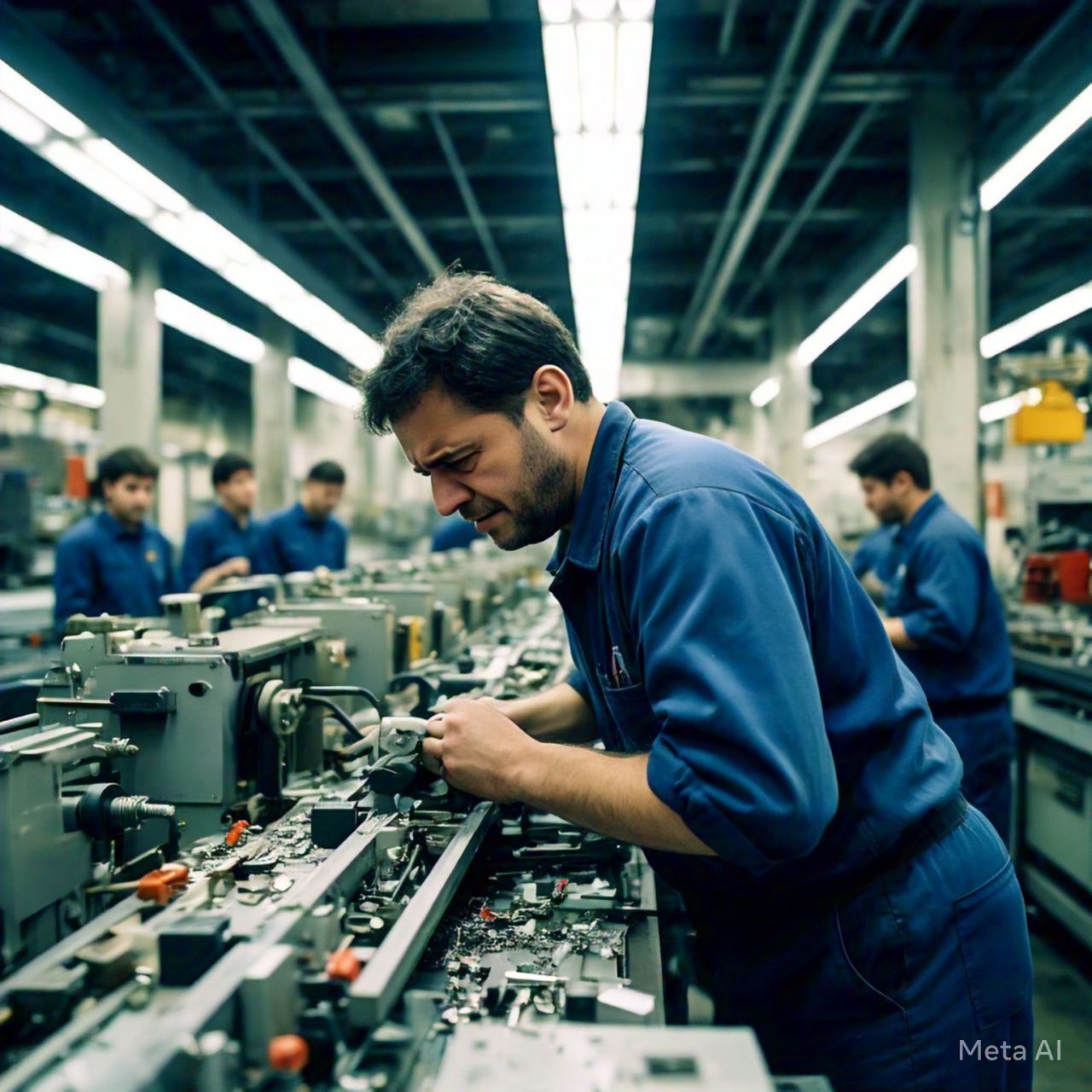Defining the Manufacturing SME Business Model
Defining the Manufacturing SME Business Model
The Manufacturing SME (Small and Medium Enterprise) Business Model involves the production of goods across various industries.
This business model encompasses businesses that transform raw materials or components into finished goods. It encompasses a diverse range of activities, from small-scale production of food and beverages to the fabrication of complex machinery and the production of high-tech electronics.
These enterprises may specialize in producing niche tools, plastics, packaging, baked goods, or digital content such as advertisements. Examples include small industrial bakeries, engineering firms creating specialized tools, and companies manufacturing plastic products.
Some key characteristics of this business model may include:
Tangible Output – The primary output is a physical product that is manufactured or assembled.
Production Processes - Involves various stages of production, such as sourcing raw materials, processing, assembly, and quality control.
Supply Chain Management – Efficient management of the supply chain is crucial, including sourcing raw materials, managing inventory, and distributing finished goods.
Innovation and Technology – Continuous innovation and the adoption of new technologies are essential for competitiveness.
Some common types of the manufacturing SME business model are:
Food and Beverage Manufacturing – Bakeries, breweries, wineries, small-scale food processing plants.
Textile Manufacturing – Garment manufacturing, textile production, shoe manufacturing.
Furniture Manufacturing – Woodworking, upholstery, custom furniture production.
Metal Fabrication – Welding, forging, machining, and other metalworking processes.
Electronics Manufacturing – Assembly of electronic components, production of electronic devices.
3D Printing – Manufacturing of products using 3D printing technology.
Custom Manufacturing – Producing customized products according to specific customer requirements.
Entry Level Expertise Requirements
Entry Level Expertise Requirements
Starting a manufacturing SME requires a foundational understanding of the production processes relevant to the chosen industry. Entry-level expertise may include knowledge in engineering, product design, logistics, and quality control. Aspiring entrepreneurs often seek resources that provide manufacturing business ideas for SMEs and on how to start a small manufacturing business to guide their initial steps.
Some of the critical skills required are:
Technical Skills – In-depth knowledge of manufacturing processes, equipment, and techniques is essential.
Business Acumen – Strong business skills, including financial management, marketing, and sales.
Problem-Solving and Analytical Skills – The ability to identify and solve production and operational challenges.
Quality Control Expertise – Ensuring the quality and consistency of products.
Technical skills combined with business acumen are crucial for navigating the complexities of manufacturing.

The Standard Regulations Applicable
The Standard Regulations Applicable
Manufacturing SMEs must adhere to stringent regulations to ensure product safety, environmental compliance, and worker welfare. These regulations often cover aspects such as waste management, emissions control, and occupational health and safety.
Some of the applicable regulations and standards requirements are:
Health and Safety Regulations – Adhering to workplace safety regulations and ensuring the safety of employees.
Environmental Regulations – Compliance with environmental regulations, including waste disposal and pollution control.
Product Safety Standards – Ensuring that products meet safety standards and comply with relevant regulations.
Licensing and Permits – Obtaining necessary licenses and permits to operate the business.
Compliance with industry standards is essential to avoid legal penalties and maintain a competitive edge.

Policies, Processes, and Procedures Framework requirements
Policies, Processes, and Procedures Framework requirements
A robust framework of policies, processes, and procedures is vital for maintaining consistency and quality in manufacturing operations. This framework includes standard operating procedures (SOPs), quality assurance protocols, and supply chain management practices.
Establishing these systems helps streamline operations and ensures that all aspects of production meet the desired standards, as highlighted in manufacturing process optimization thinking for small businesses.
Some of the common processes and procedures are:
Production Processes – Establishing standardized production processes to ensure consistency and efficiency.
Quality Control Procedures – Implementing rigorous quality control measures at each stage of the production process.
Inventory Management – Implementing effective inventory management systems to minimize waste and optimize production.
Technology and Automation requirements
Technology and Automation requirements
Adopting the latest technology and automation solutions can significantly enhance efficiency and productivity in manufacturing SMEs. Innovations such as 3D printing, robotics, and IoT (Internet of Things) are transforming traditional manufacturing processes. These technologies help reduce costs, minimize errors, and increase output.
Some of the common technologies currently applied are:
Manufacturing Equipment – Investing in modern manufacturing equipment, such as CNC machines, robotics, and 3D printers.
Automation Technologies – Implementing automation technologies to improve efficiency and reduce costs.
Enterprise Resource Planning (ERP) Systems – Utilizing ERP systems to manage production, inventory, and supply chain.
Data Analytics – Utilizing data analytics to monitor production performance, identify areas for improvement, and make informed decisions.
Entrepreneurs should explore the adoption of technology in their small manufacturing firms to stay updated on the latest trends that might assist in their efficiency and effectiveness.
Key Roles and Responsibilities (People) requirements
Key Roles and Responsibilities (People) requirements
Effective manufacturing SMEs rely on a well-structured team with clearly defined roles. Key positions include production managers, quality control specialists, logistics coordinators, and machine operators. Ensuring that employees have the necessary skills and training is critical for maintaining smooth operations.
Some of the common roles and responsibilities are:
Production Managers – Overseeing the production process, ensuring quality control, and meeting production targets.
Skilled Tradespeople – Operating machinery, performing assembly tasks, and ensuring product quality.
Maintenance Technicians – Maintaining and repairing equipment.
Quality Control Inspectors – Inspecting products to ensure they meet quality standards.
Supply Chain Managers - Managing the procurement of raw materials and the distribution of finished goods.
Life-long learning is crucial to stay up to date with the latest advancements in this business model, so information on Lean
Manufacturing Techniques for SMEs, etc. could provide guidance on optimizing your workforce efficiency.

Overall Costs and funding requirements
Starting a manufacturing SME involves significant initial investment in machinery, raw materials, and facility setup. Entrepreneurs must carefully plan their budgets and explore various funding options, such as loans, grants, or investor funding.
Some of the key costs and funding considerations are:
Capital Investment – Significant investment in manufacturing equipment, machinery, and technology.
Raw Material Costs – Costs associated with sourcing and procuring raw materials.
Labor Costs – Salaries, wages and benefits for production workers and other employees.
Operating Costs – Rent, utilities, insurance, and other overhead costs.
Funding Requirements – Access to funding sources such as bank loans, investor funding, or government grants may be necessary to finance capital investments and cover startup costs.
There are numerous funding options for small manufacturing enterprises as most governments and/or municipalities around the world generally have multiple incentives on offer for this business model.

Benefits of the Manufacturing SME Business Model
Benefits of the Manufacturing SME Business Model
Manufacturing SMEs play a crucial role in economic development by creating jobs, driving innovation, and contributing to local economies. They offer the flexibility to respond to market demands quickly and can cater to niche markets.
Some of the common benefits across the various industries are:
Potential for High Growth – Successful manufacturing businesses can achieve significant growth and profitability.
Job Creation – Manufacturing SMEs contribute significantly to job creation and economic growth.
Innovation and Creativity – Opportunities for innovation and product development.
Building a Strong Brand – Building a strong brand around high-quality products.
The potential for scalability and profitability makes this business model very attractive to upcoming varsity graduates in engineering and/or business studies.

Challenges of the Manufacturing SME Business Model
Challenges of the Manufacturing SME Business Model
Despite its advantages, the manufacturing SME model faces several challenges, including high operational costs, supply chain disruptions, and intense competition. Maintaining quality while managing costs can be difficult, particularly for new entrants.
Some of the common challenges are:
High Competition – Intense competition from larger manufacturers, both domestically and internationally.
Economic Fluctuations – Sensitivity to economic downturns and changes in consumer demand.
Technological Change – The need to continuously adapt to new technologies and manufacturing processes.
Supply Chain Disruptions – Vulnerability to disruptions in the supply chain, such as natural disasters or geopolitical events.
Environmental Concerns – Meeting environmental regulations and minimizing environmental impact.
Entrepreneurs must be prepared to navigate these obstacles, leveraging insights from challenges faced by other manufacturing SMEs to develop effective strategies.
Future Prospects of the Manufacturing SME Business Model
Future Prospects of the Manufacturing SME Business Model
The future of manufacturing is increasingly driven by technological advancements, such as Industry 4.0 technologies, including automation, robotics, artificial intelligence, and the Internet of Things.
Industry 4.0, primarily characterized by automation and data exchange, is reshaping the manufacturing landscape. SMEs that embrace these changes and adopt sustainable practices are likely to thrive.
Digital transformation and sustainable manufacturing practices in manufacturing SMEs offer a roadmap for staying competitive in this ever-evolving market.
By embracing these technologies, focusing on innovation, and prioritizing sustainability, manufacturing SMEs can remain competitive and thrive in the years to come.
The Manufacturing SME Business Model offers a dynamic and rewarding path for entrepreneurs. By addressing the challenges and capitalizing on the opportunities presented by these advancements, manufacturing SMEs can play a vital role in driving economic growth and innovation.


